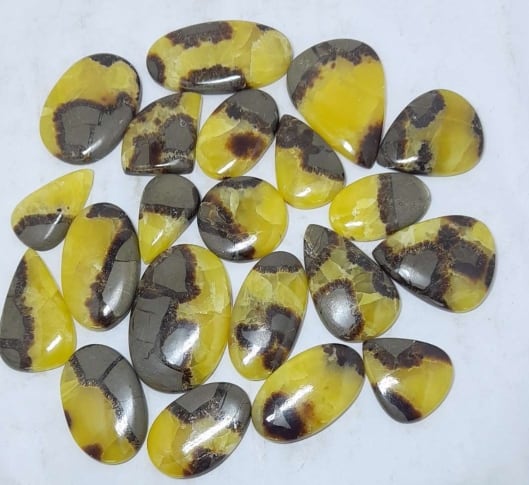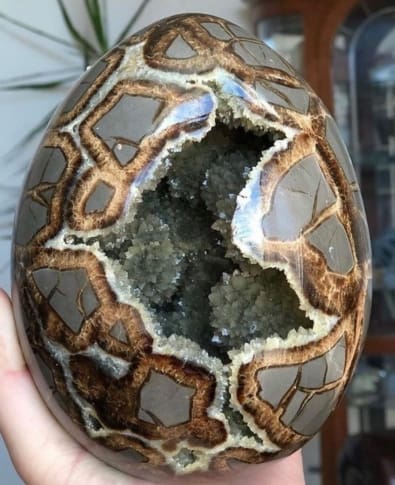Septarian nodules, also known as dragon stones, are highly sought after by rock hounds and mineral collectors because they formed millions of years ago in a unique way. These dark mud balls are distinctive stones with yellow, gray, and brown tones in large art-like bands. The grays and browns come from dead algae while the yellow crystals are made of calcite.
When talking about this mineral you’ll notice collectors interchange the word nodule and concretion. I believe the word concretion is the better word to describe a septarian nodule but I’ll leave it up to you to determine what you prefer to say. Keep reading below to find out the difference and what makes these rocks so cool.

What Is A Septarian Nodule?
Septarian nodules are a type of concretion. Mudstone combines with calcite or another carbonate-rich mineral, and the calcite follows the pattern of radiating cracks that grow during the stone’s formation.
In every case, septarian nodules are comprised of at least two minerals. The matrix of these nodules is often grey. At the same time, the interior varies from white to brown with tinges of orange throughout.
Septarian stones have a cracked egg-shaped appearance within their host rocks which gives the nodule a unique appearance when you dig it out of the ground. After the septarian nodule or concretion has been removed from the dirt, a lapidary artist will have a couple of choices to make when polishing it. They can cut the stone in half and polish the flat surfaces or polish the outside of the nodule only.
Are Septarian Nodules Rare?
Septarian nodules aren’t necessarily rare and are reasonably accessible. Smaller samples are more abundant; larger specimens are rarer when they’re cut as slabs or giant eggs.
Free-form shapes or spheres with partial openings displaying the crystals within fetch over $100. Larger specimens can be valued at well over $1,000. While some samples can be costly, it isn’t out of reach. Moderate slabs, nodules, and spheres can be found for less than $50, with smaller specimens even more affordable.
Regarding septarian jewelry, it can be just as affordable as standalone specimens. Septarian necklaces or rings can be found at about $50, but when some lux metals are added, the piece will fetch a higher price.
Where Can You Find Septarian Nodules?
Septarian nodules can be found in a few areas. Much of the material commonly seen comes from the mineral-rich island of Madagascar. The specimens from this region are typically filled with Calcite and a thin layer of Aragonite – the darker layer between the orange-to-yellow center and an exterior matrix of shale or mudstone.
Many septarian nodules come from Muddy Creek in the state of Utah. I’ve heard that some of the nodules found around Muddy Creek are filled with everything from the typical yellow calcite to stunning amethyst.
Septarian nodules are also found (in lesser amounts) along the Gulf of Mexico and Michigan. Around Michigan, these nodules are often called “Lightning Stones.”
Make sure you bring the right rockhounding tools if you decide to visit the dig site.

How To Polish Septarian Nodules
This all depends on the nodule you’re working with. Some people prefer to saw them in half before they start the polishing process. In contrast, others like to polish the exterior of the nodule.
- If you saw the nodule in half, you’ll need an 8-diamond saw machine. Or take it to a lapidary and see if they’ll cut it for you.
- After halving the nodule, you’ll have two pieces to work on the cabbing machine.
- Start with a 260-grit diamond wheel to remove the saw marks left on the flat surface.
- Next, you’ll move up to the 600-grit wheel, which will bring a dull shine to the surface of the nodule.
- Once the deep scratches are removed with the 600-grit, move up to a 1,200-grit wheel.
- You’ll notice the face of the nodule getting closer to a fine polish, but it’s not quite there.
- Next up is the 3,000-grit wheel.
- The final step is to polish the entire surface of the nodule with a 14,000-grit wheel.
A Diamond Pacific Titan Cabbing Machine or something similar is perfect for the job. The process will be the same if you choose to go with a flat lap. However, the way the stone is handled would be different.

Septarian Concretion
A concretion is a mass of mineral matter embedded within rock layers, including shale, limestone, and sandstone. They take shape when minerals settling out of water collect around a nucleus, like a leaf, pebble, bone, shell, or fossil.
Concretions are generally harder than the rocks surrounding them. Over time, concretions can weather out when the softer rock surrounding it erodes. While concretions are often rounded, they can be long, lumpy, oval, irregular, or disk-shaped. Color, hardness, and size vary, from smaller than a pin’s head to several hundred pounds.
Septarian concretions occur in the Cretaceous shales of the Smoky Hilly region. The networks of crisscrossing ridges on the exterior of a septarian concretion can give the stone a turtle shell appearance.
Septarian Geode
In contrast to most volcanic geodes, septarian geodes are a form of sedimentary geode. They formed on the sea beds millions of years ago. When they dried out, they cracked, and the interior hollows. The interior of these geodes usually became partly or entirely filled with other minerals that give Septarian unusual features and texture.
They’re unique and beautiful works of art created by nature.
Septarian geodes have a higher value than some stones. Prices vary depending on the size, type of minerals, and type of crystals. You might find smaller septarian geodes for $20 to $90, with larger and more intricate specimens ranging from $100 to $500. The larger, more profound pieces will only level up the price range.
- Identify Enstatite - March 12, 2024
- Identify Cerussite - March 3, 2024
- Identify Bytownite - February 18, 2024

8 Responses
Hi there,
Would you have a map or a more specific location at Muddy Creek? I combed the creek beds with little results and it seems they may be higher up? The owner of Joe’s Rock Shop wasn’t much help either though told he would be. Thanks from another rock hound!
L.E.
L.E.
I emailed you directly
Hello, what a great article!
I am in Idaho and have dreamed of going down to Utah to find my own nodule but I am not sure where to go specifically. I see someone else asked for more detailed directions. Could you provide those to me as well? Thank you so much!
Go to youtube and look up Rocky Mountain Ryan and Southern Utah Explorers.
Reach out to them and see if they will provide their dig locations.
I have a small round beautifully polished. After reading ur article I became very curious and want to break it open. How would I know if there are crystallized pieces inside? I’d like to open it and see what’s inside. Are there formations in every separation and is there a way to see if I should break it.
Thank u
Good article. ❤❤❤
Judy – There is no efficient way to know what is inside.
You can break it open or cut it open with a diamond saw balde.
Hi,
I found your site very helpful. Thanks for showing these beautiful Utah rocks.
Like LE says above, these are hard to find around Muddy Creek and Hanksville, at least for me. I have gone a couple of times–even down south off Highway 89–but not found them. Maybe I am just not recognizing them uncut? If you have any other tips, I would love to hear them. Thanks!
JJ – I chatted with LE and mentioned Youtube as a good resource. There are a couple of videos with rockhounds explaining where to look at how to locate a decent site for prospecting. Search for septarian nodules utah